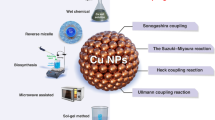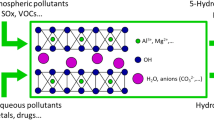Abstract
It has been well documented that urea would be slowly hydrolyzed to produce OH− and the reaction equilibrium requires relatively long times. Sometimes the samples have been achieved under high temperature (such as hydrothermal method). Here we describe systematic preparation of lanthanide hydroxycarbonate series through a facile and effective route (supersonic and microwave co-assistance) at 80 °C in less than 40 min. Product formation can be observed directly by the naked eye. Synthetic conditions were identical for all tested lanthanide elements, and corresponding nano- or micro-scale materials with different structures were obtained. A three-stage-effect was observed in crystalline phases and morphologies. More importantly, the intensive red and green emissions from europium and terbium oxycarbonates, respectively, were observed under relatively long wavelength excitations (365 or 394 nm).












Similar content being viewed by others
References
Aiken B, Hsu WP, Matijevic E (1998) Preparation and properties of monodispersed colloidal particles of lanthanide compounds: Ш, Yttrium(Ш) and mixed Yttrium(Ш)/Cerium(Ш) systems. J Am Ceram Soc 71:845–853
Alvero R, Carrizosa I, Odriozola JA, Trillo JM (1983) Activation of rare earth oxide catalysts. J Less Common Met 94:139–144
Cushing BL, Kolesnichenko VL, O’Connor CJ (2004) Recent advances in the liquid-phase syntheses of inorganic nanoparticles. Chem Rev 104:3893–3946
Drake DJ, Popović S, Vušković L (2008) Characterization of a supersonic microwave discharge in Ar/H2/Air mixtures. J Appl Phys 104:063305
Geng DL, Shang MM, Yang DM, Zhang Y, Cheng ZY, Lin J (2012) Tunable luminescence and energy transfer properties in KCaGd(PO4)2:Ln3+/Mn2+ (Ln = Tb, Dy, Eu, Tm; Ce, Tb/Dy) phosphors with high quantum efficiencies. J Mater Chem 22:23789–23798
Gorris HH, Wolfbeis OS (2013) Photon-upconverting nanoparticles for optical encoding and multiplexing of cells, biomolecules, and microspheres. Angew Chem Int Ed 52:3584–3600
Han ZH, Qian YT, Tang KB, Lu GQ, Yu SH, Guo N (2003) Hydrothermal deposition of cerium hydroxycarbonate thin films on glass. Inorg Chem Commun 6:1117–1121
Han ZH, Xu P, Ratinac KR, Lu GQ (2004) Hydroxide carbonates and oxide carbonate hydrate of rare earths grown on glass via a hydrothermal route. J Cryst Growth 273:248–257
He XB, Gao L (2009) Morphology and phase evolution of hierarchical architectures of cadmium sulfide. J Phys Chem C 113:10981–10989
Hou ZY, Chai RT, Zhang ML, Zhang CM, Chong P, Xu ZH, Li GG, Lin J (2009) Fabrication and luminescence properties of one-dimensional CaMoO4:Ln3+ (Ln = Eu, Tb, Dy) nanofibers via electrospinning process. Langmuir 25:12340–12348
Hu KW, Jhang FY, Su CH, Yeh CS (2009) Fabrication of Gd2O(CO3)2·H2O/silica/gold hybrid particles as a bifunctional agent for MR imaging and photothermal destruction of cancer cells. J Mater Chem 19:2147–2153
Ikuma Y, Oosawa H, Shimada E, Kamiya M (2002) Effect of microwave radiation on the formation of Ce2O(CO3)2·H2O in aqueous solution. Solid State Ion 151:347–352
Ji PF, Xing MY, Bagwasi S, Tian BZ, Chen F, Zhang JL (2011) Preparation with a facile template-free method of uniform-sized mesoporous microspheres of rare earth (La, Ce, Pr, Nd) oxides. Mater Res Bull 46:1902–1907
Kaczmarek AM, Miermans L, Deun RV (2013) Nano- and microsized Eu3+ and Tb3+-doped lanthanide hydroxycarbonates and oxycarbonates. The influence of glucose and fructose as stabilizing ligands. Dalton Trans 42:4639–4649
Kanari N, Mishra D, Gaballah I, Dupré B (2004) Thermal decomposition of zinc carbonate hydroxide. Thermochim Acta 410:93–100
Kini AM, Geiser U, Kao HCI, Carlson KD, Wang HH, Monaghan MR, Williams JM (1987) High-Tc superconductors: selective preparation and characterization of tetragonal and orthorhombic (93 K superconductor) phases of YBa2Cu3O7−x . Inorg Chem 26:1834–1836
Klingenberg B, Vannice MA (1996) Influence of pretreatment on lanthanum nitrate, carbonate, and oxide powders. Chem Mater 8:2755–2768
Koyabu K, Masui T, Tamura S, Imanaka N (2006) Synthesis of a new phosphor based on rare earth oxycarbonate. J Alloy Compd 408–412:867–870
Lechvallier S, Lecante P, Mauricot R, Dexpert H, Dexpert-Ghys J, Kong HK, Law GL, Wong KL (2010) Gadolinium–europium carbonate particles: controlled precipitation for luminescent biolabeling. Chem Mater 22:6153–6161
Li YX, Zhou XZ, Wang ZQ (2002) Mechanochemical reaction of lanthanum carbonate with sodium hydroxide and preparation of lanthanum oxide nanoparticle. J Rare Earths 20:411–415
Li IF, Su CH, Sheu HS, Chiu HC, Lo YW, Lin WT, Chen JH, Yeh CS (2008a) Gd2O(CO3)2·H2O particles and the corresponding Gd2O3: synthesis and applications of magnetic resonance contrast agents and template particles for hollow spheres and hybrid composites. Adv Funct Mater 18:766–776
Li CX, Yang J, Yang PP, Lian HZ, Lin J (2008b) Hydrothermal synthesis of lanthanide fluorides LnF3 (Ln = La to Lu) nano-/microcrystals with multiform structures and morphologies. Chem Mater 20:4317–4326
Lin JT, Zeng Z, Wang QM (2013) CdMoO4:Eu3+ micro-sized luminescent particles synthesis and photo-catalytic performance. Inorg Chim Acta 408:59–63
Lin JT, Zeng Z, Ma QM, Wang QM, Zhang YF (2014) Effects of multiple irradiations on luminescent materials and energy savings—a case study for the synthesis of BaMO4:Ln3+ (M = W, Mo; Ln = Eu, Tb) phosphors. Energy 64:551–556
Liu S, Ma RJ, Jiang RY, Luo FC (2000) Synthesis and structure of hydrated yttrium carbonate, Y2(Co3)33·2.79H2O. Synth React Inorg Met Org Nano Met Chem 30:271–279
Low CMR (1995) Ultrasound in synthesis: natural products and supersonic reactions? Ultrason Sonochem 2:S153–S163
Musić S, Popović S, Maljković M, Dragčević D (2002) Influence of synthesis procedure on the formation and properties of zinc oxide. J Alloys Compd 347:324–332
Niu WB, Wu SL, Zhang SF (2010) A facile and general approach for the multicolor tuning of lanthanide-ion doped NaYF4 upconversion nanoparticles within a fixed composition. J Mater Chem 20:9113–9117
Oikawa M, Fujihara S (2005) Crystal growth of Ce2O(CO3)2·H2O in aqueous solutions: film formation and samarium doping. J Solid State Chem 178:2036–2041
Panchula ML, Akinc M (1996) Morphology of lanthanum carbonate particles prepared by homogeneous precipitation. J Eur Ceram Soc 16:833–841
Panda RN, Hsieh MF, Chung RJ, Chin TS (2003) FTIR, XRD, SEM and solid state NMR investigations of carbonate-containing hydroxyapatite nano-particles synthesized by hydroxide-gel technique. J Phys Chem Solids 64:193–199
Park IY, Kim D, Lee J, Lee SH, Kim KJ (2007) Effects of urea concentration and reaction temperature on morphology of gadolinium compounds prepared by homogeneous precipitation. Mater Chem Phys 106:149–157
Pol VG, Calderson-Moreno JM, Popa M, Acharya S, Ariga K, Thiyagarajan P (2009) Synthesis of new red-emitting single-phase europium oxycarbonate. Inorg Chem 48:5569–5573
Qian LW, Wang X, Zheng HG (2012) Controlled synthesis of three-fold dendrites of Ce(OH)CO3 with multilayer caltrop and their thermal conversion to CeO2. Cryst Growth Des 12:271–280
Radwan AA, Alanazi FK, Alsarra IA (2010) Microwave irradiation-assisted synthesis of a novel crown ether crosslinked chitosan as a chelating agent for heavy metal ions (M+n). Molecule 15:6257–6268
Sankar R (2008) Efficient green luminescence in Tb3+-activated borates, A6MM′(BO3)6. Opt Mater 31:268–275
Shang XF, Lu WC, Yue BH, Zhang LM, Ni JP, Lv Y, Feng YL (2009) Synthesis of three-dimensional hierarchical dendrites of NdOHCO3 via a facile hydrothermal method. Cryst Growth Des 9:1415–1420
Shang MM, Li GG, Kang XJ, Yang DM, Geng DL, Lin J (2011) Tunable luminescence and energy transfer properties of Sr3AlO4F:RE3+ (RE = Tm/Tb, Eu, Ce) phosphors. ACS Appl Mater Interfaces 3:2738–2746
Sheu HS, Shih WJ, Chuang WT, Li IF, Yeh CS (2010) Crystal structure and phase transitions of Gd(CO3)OH studied by synchrotron powder diffraction. J Chin Chem Soc 57:938–945
Sivakumar S, van Veggel FCJM, Raudsepp M (2010) Bright white light through up-conversion of a single NIR source from sol–gel-derived thin film made with Ln3+-doped LaF3 nanoparticles. J Am Chem Soc 2127:12464–12465
Song WS, Lee KH, Do YR, Yang H (2012) Utilization of all hydrothermally synthesized red, green, blue nanophosphors for fabrication of highly transparent monochromatic and full-color plasma display devices. Adv Funct Mater 22:1885–1893
Sun J, Kyotani T, Tomita A (1986) Preparation and characterization of lanthanum carbonate hydroxide. J Solid State Chem 65:94–99
Wang X, Li YD (2002) Synthesis and characterization of lanthanide hydroxide single-crystal nanowires. Angew Chem Int Ed 41:4790–4793
Wang G, Wang H, Bai JT, Ren ZY, Bai JB (2013) PVP-assisted assembly of lanthanum carbonate hydroxide with hierarchical architectures and their luminescence properties. Chem Eng J 214:386–393
Xiao MW, Wang LS, Wu YD, Huang XJ, Dang Z (2008) Preparation and characterization of CdS nanoparticles decorated into titanate nanotubes and their photocatalytic properties. Nanotechnology 19:051706
Xie LP, Song HW, Wang Y, Xu W, Bai X, Dong B (2010) Influence of concentration effect and Au coating on photoluminescence properties of YVO4:Eu3+ nanoparticle colloids. J Phys Chem C 114:9975–9980
Xu ZY, Zhang YJ, Fang ZY, Yin XB, Zhu W (2010) Controllable synthesis and optical properties of NdOHCO3 dodecahedral microcrystals. Mater Res Bull 45:74–79
Yu SH, Han ZH, Yang J, Zhao HQ, Yang RY, Xie Y, Qian YT, Zhang YH (1999) Synthesis and formation mechanism of La2O2S via a novel solvothermal pressure-relief process. Chem Mater 11:192–194
Zhang YJ, Han KD, Cheng T, Fang ZY (2007) Synthesis, characterization, and photoluminescence property of LaCO3OH microspheres. Inorg Chem 46:4713–4717
Zhang YJ, Gao MR, Han KD, Fang ZY, Yin XB, Xu ZY (2009) Synthesis, characterization and formation mechanism of dumbbell-like YOHCO3 and rod-like Y2(CO3)3·2.5H2O. J Alloy Compd 474:598–604
Zhang YJ, Xu ZY, Yin XB, Fang ZY, Zhu W, He HM (2010) Controllable synthesis of EuCO3OH microspheres and their thermal conversion to Eu2O3. Cryst Res Technol 45:1183–1188
Zhang YD, Pan CC, Zhang YG, He WW (2011) Self-template hydrothermal synthesis ZnS microspheres. Cryst Res Technol 46:718–722
Zhang N, Salzinger S, Deubel F, Jordan R, Rieger B (2012a) Surface-initiated group transfer polymerization mediated by rare earth metal catalysts. J Am Chem Soc 134:7333–7336
Zhang YJ, He HM, Yang XZ, Zheng A, Fan Y (2012b) Morphology-controlled synthesis, characterization, growth mechanism of SmOHCO3 with high uniform size and photoluminescence property of SmOHCO3:Eu3+. Powder Technol 224:175–182
Zhao DL, Yang Q, Han ZH, Zhou J, Xu SB, Sun FY (2008) Biomolecule-assisted synthesis of rare earth hydroxycarbonates. Solid State Sci 10:31–39
Zhu L, Liu YJ, Fan XZ, Yang DW, Cao XQ (2011) Rapid synthesis of single-crystalline TbF3 with novel nanostructure via ultrasound irradiation. Mater Res Bull 46:252–257
Acknowledgments
This study was supported by the Scientific Research Foundation of Graduate School of South China Normal University. Q. M. appreciates support from the National Natural Science Foundation of China (No. 21371063) and excellent university young scholar fund of Guangdong Province (Yq2013053) and Science and Technology Project in Guangzhou (2014J4100054).
Author information
Authors and Affiliations
Corresponding authors
Electronic supplementary material
Below is the link to the electronic supplementary material.
Rights and permissions
About this article
Cite this article
Lin, J., Zheng, Y. & Wang, Q. Slow release realized in 40 min? Assembly of lanthanide hydroxycarbonates and oxycarbonates based on multiple irradiations. J Nanopart Res 16, 2552 (2014). https://doi.org/10.1007/s11051-014-2552-6
Received:
Accepted:
Published:
DOI: https://doi.org/10.1007/s11051-014-2552-6




